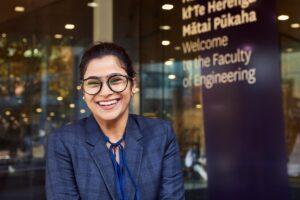Women in Engineering: Ankeeta Karmakar
 Why did you come to New Zealand?
Why did you come to New Zealand?
When I was considering different universities across the world to study as an international student, I was looking for a Master’s programme that would focus on earthquake engineering.
Most of the programmes that I found were master of civil and/or structural engineering, so when I discovered the University of Auckland’s Master of Earthquake Engineering programme, I just couldn’t think of any other school.
I belong to a region, Assam (North-eastern part of India), where earthquakes are frequent. I wanted to pursue this path so I can apply my learnings both here in New Zealand and back in my native India to build an earthquake-resilient society.
So, here I am, pursuing my PhD in Civil Engineering, specialising in Earthquake Engineering. I successfully completed my Master of Earthquake Engineering last year in November and started my PhD in December 2022.
Earthquake research is big for you?
It is indeed. I fear earthquakes a lot and recognise that pursuing a career in this space will help me to overcome this fear, while also contributing knowledge and insight to how governments can improve their response when crisis does strike.
This is particularly relevant to New Zealand, where GNS records more than 20,000 earthquakes in the country per year, of which about 100 are felt. The research that comes out of the University of Auckland is world-renowned, and I have gathered a huge amount of knowledge during my Masters programme that will help in developing an earthquake-resilient society in New Zealand, as well as in India.
How can NZ make residential properties more earthquake resilient?
With mindful research and use of available resources.
Does your research suggest that NZ must be more mindful as to where building is done?
It is hugely important to be mindful of building, especially in cities where density is increasing. In growing cities with limited access to space, it will be difficult to relocate people to a safer place temporarily while a building is repaired following an earthquake.
Through my PhD research I want to make a building earthquake resilient using available resources. This would be helpful to mitigate post-earthquake costs and social disruptions.
Who are your role models?
I got a taste of civil engineering from my father, who is a retired civil engineer. When I was a kid, I always saw him doing calculations, drawing sketch after sketch of the bending moment, shear forces, and building design details.
Back then, I couldn’t fathom what those were but after high school, I knew I had to pursue the field that my father pursued. Without him, I wouldn’t have succeeded in whatever I was doing.
In the future, I see myself as following the footsteps of my supervisor at the University of Auckland, Professor Charles Clifton in 10-15 years. In my academic journey, he has been a constant support.
Greatest inspiration?
My father’s words are my greatest inspiration. I talk with him 2-3 times a day. I tell him how my day goes and if there are any problems, it’s him I discuss them with.
Each time he has a solution, or even if he doesn’t, he just calms me down. Father, I love you.
Favourite book?
Abundance Now by Lisa Nichols.
How do you relax?
Well, I sketch different types of mandala (dot art, free hand, graphic) to soothe my mind. It is also a fun way for me to pass my time. I have made hundreds of mandala and the biggest I could go to is A1.



